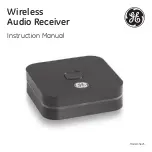
K1EL
WKUSB with WinKeyer3 User Manual
WKUSB
WKUSB User Manual
12/20/2017 Rev 1.0
Page 46
Embedded Command Examples
/B60BCON DE K1EL BEDFORD NH
send BCON DE K1EL BEDFORD NH every 60 seconds
UR RST IS /P QSL
pause to allow the user to enter the RST then resume automatically
/K05 /W10 VVV DE K1EL
key down for 5 secs, wait 10 secs, and then send VVV DE K1EL
CQ CQ CQ DE /M /M /M
send a 3x3 CQ using the user callsign
/H2CQ CQ DE K1EL K1EL K1EL/S15 DE K1EL
send 1
st
part at 1500 lpm and the 2
nd
at 15 WPM
CQ CQ CQ DE K1/I10TMT/I00 K
send message with 20% extra space in TMT. A more manageable way of
doing this would be to load
K1/I10TMT/I00
in the callsign slot to get this spacing any time /M is used.
CQ CQ CQ DE /Z4K1EL K1EL K1EL/Y4 K
send the callsigns 4 WPM slower then return to normal WPM.
QTH IS /E/C1/E NAME IS STEVE
play the QTH from message bank 1 and then return for the name.
/Q2EL /1
continuously send EL at QRSS10 speed (this message is in slot 1). Avoid inserting a space
between the QRSS command and the start of text: /Q2 EL unless you want a long delay at start of message.
/B10K1EL BCON/W2/VVOLTS
send K1EL BCON, wait 2 secs, send XrXX VOLTS repeat every 10 secs
SOM/E/C3/E/U1/W5/U0/S50K1EL//1/XEOM
send SOM, swap to msg bank 2, call msg 3, swap back to msg
bank 1, turn on PTT for 5 seconds. Change speed to 50 WPM send K1EL/1, cancel 50WPM send EOM.
Standalone Beacon Operation
There are several ways to run a beacon from WK in standalone mode. The first way is to load a message
followed by a delay and jump. This would look like this, loaded into slot one:
K1EL BCON /W12 /J1
K1EL BCON will be sent followed by a 12 second delay after which there is a jump back to the beginning.
The second way is to use the embedded beacon command, which is easier:
/B12K1EL BCON
Again K1EL BCON will be repeated every 12 seconds, but now the time between beacons will be exactly 12
seconds. In the previous example, the time between beacons would be 12 seconds plus the time it takes to send
the message. This is more in line with what most users a looking for.
Finally, the third method is an ‘on the fly’ beacon. In this mode, any message slot can be sent as a beacon, for
example if K1EL BCON is loaded into slot three, the user would press the command button, wait for the R, and
then enter
B 3 12
. This will beacon message 3 every 12 seconds. The advantage is that the message does not
specifically have to be formatted as a beacon. The disadvantage is you have to enter the beacon paddle
command every time you want to send it.
One application of a beacon is to set up a CQ loop that will send CQ, pause for some length of time, and then
send it again until someone answers. If the beacon is in the pause state, you can simply answer and this will end
the beacon. If the beacon is in the middle of the message, pressing the paddle once will halt the message
allowing you to listen and then break in to answer. If you are waiting in the pause state and you want to halt the
beacon but not send anything yet, multi-press PB4 and the CMD PB.








































